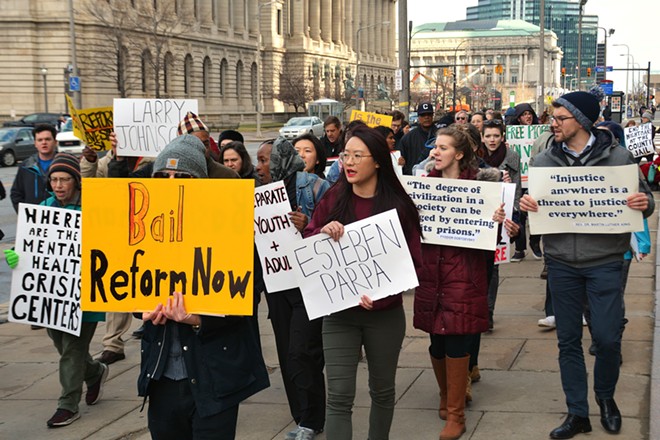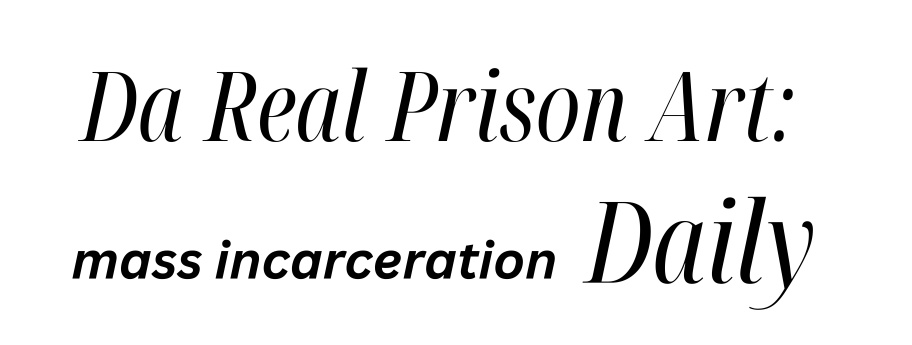
Nick Castele/Ideastream Public Media
Bail reform advocates protest Cuyahoga County Jail conditions in January 2019.
This article was published in partnership with The Marshall Project, a nonprofit news organization covering the U.S. criminal justice system. Sign up for their newsletters, and follow them on Instagram, TikTok, Reddit and Facebook.
Calls for bail reform are not new in Cleveland or across the country.
More than 50 years ago, the Federal Bail Reform Act of 1966 created a new standard which favored releasing most defendants from jail in non-death penalty cases. It also added the options for judges to set conditions for release, such as electronic monitoring or drug screening.
Federal bail laws were changed again in 1984, tipping the scales back toward keeping defendants locked up pending trial. The laws also allowed judges setting bail to consider whether a person posed a danger to community safety.
The most recent push for what’s sometimes called pretrial justice started in the 2010s. The federal government supported evidence-based practices, and reform took off as journalists told stories about the toll of money bail. One of the most well-known stories was that of Kalief Browder, who spent three years at New York City’s Rikers Island before charges against him were dropped. He was released, but later died by suicide. Illinois recently became the first state to completely eliminate cash bail after a state Supreme Court decision found it is not mandated by the state constitution. (Learn more about the state of bail reform from The Marshall Project.)
The paths to bail reform elsewhere have included statewide legislation, civil rights lawsuits and systems change on the local level. In Cleveland, the most recent push for reform started around 2016. Since then, justice system officials have discussed, debated and studied the issue. They’ve implemented some changes that have reduced the overall use of cash bail but have not eliminated it.
August 2016: The Plain Dealer and Cleveland.com kick off Justice for All, a series of articles looking at Cuyahoga County’s current bail system and advocating for reform.
Fall, 2016: The Court of Common Pleas starts to examine how bail is used across Cuyahoga County. The county works with the American Civil Liberties Union of Ohio and the national Pretrial Justice Institute to create a snapshot of people released from several municipal jails and the county jail on the same day, and to get feedback from players in the court system.
The report, completed in September 2017, found that even though the number of criminal cases filed had dropped, the number of people sitting in jail had not, and the county jail was often at capacity.
- People who were released from jail on personal or money bonds had an average jail stay of 17 days.
- 28% of defendants with a bond of $5,000 or less never posted it and remained detained while their cases were pending.
December 2016: Cleveland Municipal Court, the largest of Cuyahoga County’s 13 municipal courts, announces it will partner with the nonprofit Laura and John Arnold Foundation to explore using risk assessments and other tactics to reduce the use of money bail. (Full disclosure: Arnold Ventures LLC is a funder of The Marshall Project through philanthropic organizations it administers, including the nonprofit Laura and John Arnold Foundation. Under the terms of its funding, The Marshall Project has sole editorial control of its news reporting.)
2016: The Common Pleas Court phases in a “first appearance docket” so felony judges can more quickly review bail set in municipal courts before a case is considered by a grand jury. The goal is for defendants who post bond at the municipal court level to have a county hearing within four days, and defendants who remain in jail to have a hearing within two days. It also speeds up the appointment of attorneys.
June-Dec. 2018: Eight people being held in the Cuyahoga County jail die in one year from drug overdoses, medical issues, acts of violence and suicide. Many of them are being held for minor crimes or probation violations. The deaths lead the U.S. Marshals Service to investigate.
March 2018: Cuyahoga County Bail Reform Task Force report makes sweeping recommendations, including creating centralized booking and bail hearings and a countywide pretrial justice system that includes the 13 municipal courts and the county common pleas court. The report also recommends that judges default to setting a personal bond in certain low-level and nonviolent cases.
April 2018 – Dec. 2019: Common Pleas Court Administrative and Presiding Judge John J. Russo changed long-standing practice by limiting private conversations between the bond commissioner’s office and police, prosecutors or defense attorneys about bail prior to arraignment. The court also started having the bond commissioner recommend personal bonds in non-violent fifth-degree felony cases, Russo said in a 2019 letter.
June 2018: County leaders announce the formation of a Criminal Justice Council that includes representatives from law enforcement, prosecutors, criminal defense attorneys, local officials and advocacy groups. The council agrees to collaboratively tackle justice reform, including bail, and the treatment of defendants with mental health concerns.
Sept. 24, 2018: Cleveland Municipal Court launches its pretrial services program. It includes text reminders for court dates and electronic monitoring. In the first year of the program, the percentage of defendants who fail to show up for a court date is cut in half, according to the court. About 8% of defendants are charged with a new offense after their release.
Nov. 2018: A U.S. Marshals report finds inhumane conditions and civil rights violations in the crowded county jail. Pete Elliott, the U.S. Marshal for the Northern District of Ohio, calls the jail one of the “worst in the country.”
July 2019: The Bail Project launches in Cleveland. It starts to post bonds for defendants and support them when they are released.
July 2019: An Ohio Supreme Court task force examines the state’s bail system and makes several recommendations, including:
- Make a pretrial release risk assessment tool available to all judges statewide.
- Require counties with more than one municipal court to use standard bond amounts based on a defendant’s charges when a judge is not available to make a release decision.
- Require defense attorneys be present during a bail hearing if a person could be detained.
- Create more alternatives to pretrial detention and collect better data on bail and pretrial detention.
Aug. 28, 2019: Cuyahoga County Prosecutor Michael O’Malley puts in writing the office’s practice of not asking for cash bonds or objecting to personal bonds in lower-level felony cases that don’t involve violence — unless there’s evidence that the person is a risk to a person or the community.
July 2020: New statewide rules governing criminal cases issued by the Ohio Supreme Court require courts to release a defendant on the “least restrictive conditions” that will reasonably assure the defendant will return to court, protect the safety of the community and not obstruct the criminal justice process.
September 2020: The ACLU of Ohio releases the results of a two-year project to determine cost savings of bail reform. The report, which included Cuyahoga County cases, also looked at racial disparities in the current bail system. An economist hired by the civil rights organization estimated the state could save as much as $264 million a year by releasing people charged with misdemeanors and most felonies instead of keeping them detained.
November 2020: Common Pleas Court Administrative and Presiding Judge Brendan Sheehan instructs the court’s bond commissioner to recommend personal bonds — which don’t require a payment for release — in third, fourth and fifth degree felonies cases that don’t include an allegation of violence.
March 2021: The ACLU of Ohio releases a report on the impact of cash bail on sentencing outcomes. The report, which included Cuyahoga County cases, finds that the longer a person sits in jail, the more likely they are to be convicted and get a lengthier jail or prison sentence.
May 2021: Bills introduced in the Ohio House and Senate would require courts to release defendants on a personal bond unless there is a safety risk or a flight risk. The bills also would require courts to consider the ability to pay when setting the bond amount. Legislation is backed by a broad coalition including Americans for Prosperity, ACLU of Ohio and the Ohio Public Defender. The legislation stalls.
July 2021: New statewide rules issued by the Ohio Supreme Court go into effect, requiring Ohio counties to first consider personal bonds before setting monetary bail, and for counties with more than one municipal or county court to set bail standards for all courts to use.
January 2022: Ohio Supreme Court rules in DuBose V. McGuffey that a judge can’t set financial conditions of bail that are higher than the amount reasonably necessary to make sure a person shows up for court proceedings, and that public safety can no longer be a consideration for monetary bail.
June 2022: Republican lawmakers in Ohio vote to put a proposed constitutional amendment on the statewide ballot. A majority of voters would have to approve the amendment, which would require judges setting bail to consider public safety and shift oversight of bail from the Ohio Supreme Court to the legislature.
Nov. 8, 2022: Ohio voters overwhelmingly decide to amend the state’s constitution to include specific factors that judges have to consider when setting bail amounts and conditions, including: public safety, the seriousness of the offense, a person’s criminal record, and the likelihood a person will return to court. This strips the Ohio Supreme Court of the authority to set bail rules and practices and gives that power to the state legislature.
Subscribe to Cleveland Scene newsletters.
Follow us: Apple News | Google News | NewsBreak | Reddit | Instagram | Facebook | Twitter | Or sign up for our RSS Feed
This post was originally published on this site be sure to check out more of their content.






